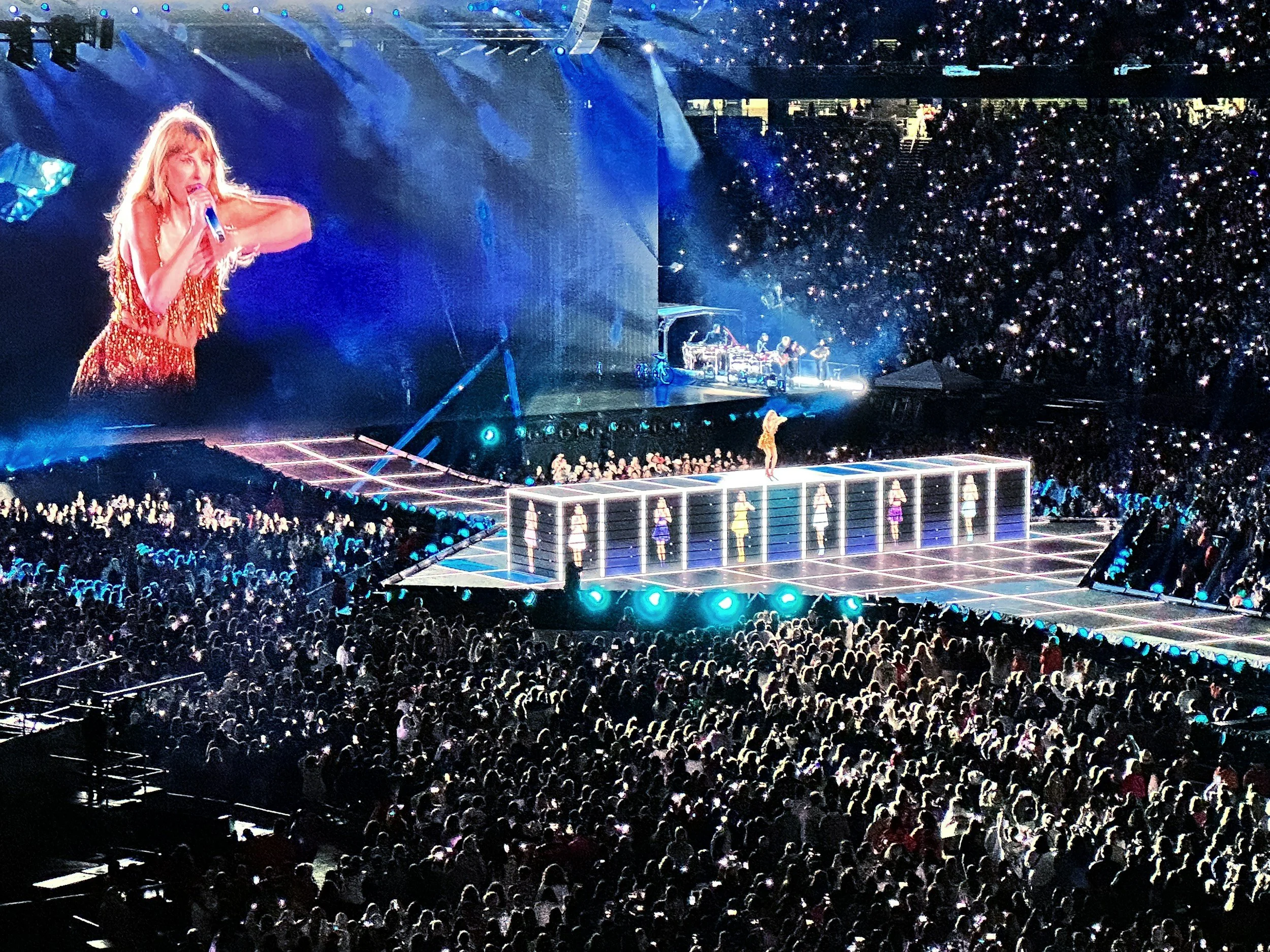The Taylor Swift Approach to Business Systems That Scale
If there’s one thing I’ve learned in business (and in life), it’s that success doesn’t come from winging it — it comes from building something that works behind the scenes, over and over again.
At MEESH Agency, that’s exactly what we do!
We help creative businesses in industries like marketing, fashion, retail, entertainment, and tech go from disorganized and reactive to structured, strategic, and scalable. Because behind every thriving brand is a system that keeps it all together. If that system’s missing? Growth stalls, opportunities slip, and creativity gets buried under chaos.
And since we’re talking about systems, let’s take a little inspiration from someone who knows a thing or two about building them: Taylor Swift.
Yes, that Taylor Swift.
It might sound funny at first, but the truth is — Taylor is one of the best examples of strategic, system-driven execution we have today. From her global tours and album rollouts to how she communicates with her audience and expands her brand empire, nothing about her success is accidental. Everything is structured. Everything is planned. And everything — every song release, every fan drop, every surprise announcement — is part of a bigger system.
So let’s talk about how that same approach applies to your business, and how building strong project management systems, automations, and integrations can change the way you operate and scale.
Why Systems Are the Secret Behind Every “Sold-Out Tour”
When Taylor stepped on Good Morning America to announce her latest docuseries and concert film, the internet exploded. Headlines, social media, pre-orders, think pieces — it was everywhere.
But here’s the real story: that announcement was just one piece of a much bigger system. The media rollout, press strategy, content scheduling, production timelines, and even the fan engagement campaigns that followed — none of it happened by chance.
Behind the scenes, there are teams, timelines, automations, workflows, and integrations all working together to make sure every detail lands at the right time, in the right place, with the right impact.
That’s exactly how your business should run, too.
Whether you’re launching a new fashion collection, producing a campaign for a client, or preparing to roll out a SaaS product, you’re dealing with moving parts: tasks, deadlines, deliverables, approvals, communication, marketing, reporting. Without a system, those parts stay scattered — and when things are scattered, growth slows down.
But with the right systems in place?
Everything starts clicking. Tasks move forward without constant check-ins. Automations handle the repetitive work. Integrations keep data flowing without manual effort. And most importantly — your team is free to focus on creating, not putting out fires.
Building the Backbone: Your “Setlist” for Projects
Every Taylor Swift concert is an experience. The setlist isn’t random — it’s carefully crafted to build momentum, balance energy, and deliver a show that keeps people talking. Your project system should do the same thing.
Think of your workflows as the “setlist” of your operations — the roadmap that keeps everything flowing in order.
Here’s what that often looks like:
Discovery & Strategy: What’s the goal? What are the outcomes? Who’s involved?
Planning & Setup: Break down deliverables, assign tasks, and set realistic timelines.
Execution & Production: The creative work happens here — design, development, writing, production.
Review & Quality Control: Time to refine. Feedback, edits, and approvals all happen here.
Launch & Delivery: The big reveal — the campaign goes live, the product launches, the event happens.
Optimization & Retrospective: Measure results, analyze data, and identify opportunities to improve.
Most businesses have some version of this process but too often, it’s living in people’s heads, scattered across inboxes, or buried in a dozen disconnected tools. A real project management system makes this process visible, trackable, and repeatable.
That’s where platforms like Monday.com, Asana, ClickUp, or Trello come in. They help you build a structured “tour plan” for your business — one that doesn’t just live on a whiteboard or sticky notes but actively drives execution.
Automations: The Invisible Crew Making the Magic Happen
Here’s the thing: Taylor isn’t backstage swapping microphones and setting up pyrotechnics. There’s a crew — a massive one — handling all the moving parts behind the scenes so she can stay in the spotlight.
Automations are your business’s version of that crew.
When done right, automations eliminate repetitive tasks, reduce human error, and keep projects moving without you constantly pushing them forward. And they’re not just a “nice to have” — they’re the difference between a business that runs you and a business that runs for you.
Some examples of where automations shine:
Client onboarding: A signed proposal automatically creates a new project, assigns tasks, sends a welcome email, and schedules a kickoff call.
Task sequencing: When one task is completed, the next one triggers automatically, assigned to the right person.
Communication: Status updates are automatically sent to clients or team members at key milestones.
Follow-ups: If feedback isn’t received by a deadline, an automated reminder goes out — no manual chasing required.
In other words, automations keep your business humming in the background, so you and your team can focus on strategy, creativity, and innovation — the parts of the job that actually move the needle.
Integrations: The Band Playing in Sync
A Taylor Swift show isn’t just Taylor. It’s the band, the lighting crew, the dancers, the sound engineers — each doing their part in perfect harmony.
That’s what integrations do for your business. They connect the tools you use every day so that data flows effortlessly between them, eliminating silos and duplicate work.
If your project management tool doesn’t talk to your CRM, if your file storage isn’t synced with your task list, or if your communication platform isn’t integrated with your automations — you’re leaving efficiency on the table.
Here’s how integrations can transform your operations:
A lead enters your CRM → a ClickUp project board is automatically created.
A client uploads files to Google Drive → a task is triggered in Monday.com.
A task status changes to “Ready for Review” → a Slack notification is sent to the team.
A campaign is marked complete → a report is generated and sent to the client.
The goal is simple: build a business where the tech does the heavy lifting and the humans focus on high-value work.
How This Translates Across Industries
Different industries have different types of chaos but the need for systems is universal. Let’s break it down by some of the key sectors MEESH Agency supports:
Fashion & Retail
Trends shift fast. Collections need to move from concept to production to storefront on tight timelines. Without systems, production gets delayed, marketing campaigns misalign, and launches flop.
With the right systems:
Sample approvals automatically trigger production workflows.
Inventory updates sync directly with e-commerce platforms.
Marketing campaigns are scheduled to launch the moment products drop.
Real-time dashboards show sales, stock levels, and performance data in one place.
It’s the difference between a chaotic runway scramble and a flawlessly timed fashion week debut.
Marketing & Creative Agencies
Agencies juggle multiple clients, multiple campaigns, and endless assets. Without structure, things fall through the cracks — and clients notice.
With systems:
Creative briefs automatically generate task lists and timelines.
Feedback cycles are automated, so nothing stalls waiting for approvals.
Campaign performance reports pull from multiple platforms and update in real time.
Every deliverable is tracked, visible, and accountable.
Think of it as choreography — every team member knows their cue, and the whole campaign comes together like a show-stopping finale.
Tech Startups
Startups grow fast and disorganization grows even faster. Without systems, releases are missed, onboarding breaks down, and scaling becomes a mess.
With systems:
New feature requests automatically flow into development sprints.
QA processes are triggered as soon as code is pushed.
Customer onboarding sequences launch automatically when new users sign up.
Product analytics integrate directly with support and CRM tools for a 360° view.
This is the difference between a scrappy garage band and a global headliner.
Entertainment & Production
From live events to digital content, entertainment projects have countless moving pieces. Systems are the only way to keep them all aligned.
With systems:
Vendor onboarding, contracts, and approvals happen automatically.
Post-production workflows trigger based on status updates.
Asset reviews are centralized and version-controlled.
Marketing and press schedules integrate with production timelines.
It’s the backstage crew that makes sure the show goes on.
Rolling It Out Like a Taylor Swift Album Drop
Even the best system won’t work if your team doesn’t use it. That’s why rollout matters. And who better to take notes from than Taylor, the master of strategic releases?
Here’s how to launch your new system with the same kind of impact:
Build Anticipation: Announce the changes ahead of time. Show your team how the new system will make their lives easier.
Launch in Phases: Don’t try to overhaul everything at once. Start with one department or one project and build from there.
Tell the Story: People don’t buy into tools, they buy into transformation. Explain the “why” behind the change.
Train Like a Tour Rehearsal: Offer workshops, walkthroughs, and real-life examples. Let your team practice before it’s live.
Celebrate Wins: Highlight early successes. Show how much time you’re saving or how much smoother client projects are running.
The more intentional you are about rollout, the faster adoption happens and the sooner your investment starts paying off.
The Pitfalls That Can Derail the Show
Even the most perfectly planned tour can have a mic glitch or a lighting fail. The same goes for system builds. Here are a few common mistakes I see businesses make (and how to avoid them):
Over-Automating: Automations are powerful, but if you try to automate everything, you’ll lose flexibility. Start with the 20% of tasks that happen most often.
Tool Overload: More isn’t better. Choose tools that play well together and solve specific problems, don’t chase shiny objects.
Skipping Error Handling: Always plan for what happens if something breaks. Build in alerts, backups, and fail-safes.
Forgetting the Human Side: Systems only work if people use them. Make sure they’re intuitive, accessible, and supported with training.
Not Measuring Success: Track metrics from day one. If you’re not measuring time saved, error rates reduced, or revenue gained, you won’t know if your system is actually working.
Why This Matters More Than Ever
Here’s the truth most business owners don’t talk about: growth isn’t about working harder. It’s about removing friction so your best work can happen consistently, even on the days you’re not in the room.
Taylor doesn’t run around managing every light cue, costume change, and stage setup. She built the infrastructure that makes those things happen without her. And that’s why she can scale — tours, albums, partnerships, billion-dollar business ventures — without burning out.
You deserve that too.
You deserve a business that runs smoothly without you micromanaging every detail. One that supports your creativity, instead of draining it. One that grows without chaos — and gives you the freedom to focus on the vision you started with.
Final Thoughts: From Chaos to Clarity
At MEESH Agency, we believe building systems isn’t about stripping away creativity — it’s about protecting it. It’s about creating a foundation strong enough to hold the weight of your ideas and flexible enough to grow with your ambitions.
Whether you’re running a boutique fashion label, building the next big marketing agency, or scaling a tech startup, the truth is the same: success requires structure. Creativity thrives on clarity. And chaos? That’s just potential waiting to be organized.
So if you’re ready to stop putting out fires and start building something that scales — it’s time to get serious about your backend. Let’s build the tour infrastructure for your business so you can stay on stage where you belong.
Book a Clarity Call with MEESH Agency today, and let’s turn your chaos into a standing ovation-worthy operation.
MEESH Agency — Where Organizing Chaos Is an Art.




